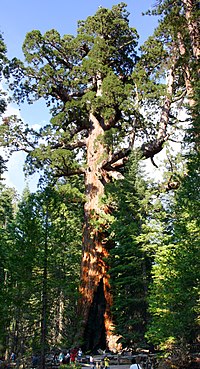Mariposa Grove



Mariposa Grove is a sequoia grove located near Wawona, California in the southernmost part of Yosemite National Park, at 37°31′N 119°36′W / 37.517°N 119.600°W. It is the largest grove of Giant Sequoias in the park, with several hundred mature examples of the tree. Two of its trees are among the fifty largest such trees in the world.
The Mariposa Grove was discovered by Galen Clark and Milton Mann, in 1857. They named the grove after Mariposa County, California, where the grove resides [1].
The Giant Sequoia named Grizzly Giant is, at between probably 1600-2000 years old ([2]), the oldest tree in the grove. In 1932 it was claimed to be the fifth largest (by volume) tree in the world, but other trees were subsequently found to be larger; it currently has a volume of 963 cubic meters, only the 27th largest. It is 63 m tall, and has a heavily buttressed base with a basal circumference of 28 m (92 feet) or a diameter of 8.9 m (29 feet); above the butresses at 2.4 m above ground, the circumference is only 22 m (diameter 7 m). Grizzly Giant's first branch from its base is itself 2 m (6 feet) in diameter.
Another tree, the Wawona Tree, had a tunnel wide enough for horse-drawn carriages and early automobiles to drive through, cut through it in the nineteenth century. Weakened by this large opening at its base, the tree fell down in 1969.
Abraham Lincoln signed an Act of Congress on June 30, 1864 ceding the "Mariposa Big Tree Grove" (and Yosemite Valley) to the state of California; criticism of the stewardship over the land led to the state returning the grove to federal control upon establishment of Yosemite National Park.
The Mariposa Grove Museum is listed on the National Register of Historic Places.
Noteworthy trees
Some of the trees found in the grove that are worthy of special note are:
- The Fallen Monarch: A tree that toppeled over hundreds of years ago (Giant Sequoias are resistant to decay, so their remains can linger for an unknown period of time, if undisturbed).
- The Bachelor and Three Graces: A group of four trees, three of them growing very close together, with a fourth a little more distant. Their roots are so intertwined that if one of them were to fall, it would likely bring the others along with it.
- The Grizzly Giant: The oldest tree in the grove.
- The California Tunnel Tree: Cut in 1895 to allow coaches to pass through it (and as a marketing scheme to attract visitors to the grove), this is the only living tree with a tunnel in it since the fall of the Wawona Tunnel Tree in 1969.
- The Faithful Couple: A rare case in which two trees grew so close together that their trunks have fused together at the base.
- The Clothespin Tree: Countless fires throughout the decades nearly severed this tree's trunk, creating a space in it large enough for a pick-up truck to drive through.
- The Telescope Tree: A tree that repeated fires, down the decades, have left completely hollow. In spite of that, the tree is still living, as Giant Sequoias do not require a whole trunk to survive. It is possible to walk inside the tree and, from there, see the sky. Similarly to the Clothespin Tree, this condition leaves the tree weakened and makes it more difficult for it to withstand strong winds. For that, this tree (and the Clothespin Tree) could topple at any time.
- The Columbia Tree: The tallest tree in the grove and in Yosemite National Park.
- The Galen Clark Tree: Of historical importance, it is supposed to have been the first tree seen by Galen Clark upon his entrance in the grove, and which would have inspired his love for the Giant Sequoias that would drive him to struggle for the setting aside of land for preservation, something that was unheard of in the mid-19th century.
- The Wawona Tunnel Tree: Renamed to "The Fallen Tunnel Tree" after it toppled over during a snow storm in 1969. This was the first tree to have a tunnel carved through its trunk, in 1881. Its collapse is seen as a turning point in the preservation of wildlife in National Parks in the United States. So grave was the shock of its collapse that it brought about a greater awareness of how sensitive an ecosystem can be, even in regard to beings as massive as the Giant Sequoias.
- The Fallen Giant: It was one of the largest trees in the grove, until it fell, in 1873.
- The Massachusetts Tree: It was one of the most famous trees in the grove. It fell in 1927.
→ Other fallen trees that may be seen in the grove include: The Mark Twain Tree (fell in 1943), The Utah Tree (fell April 7, 1935), The Stable Tree (fell August 28, 1934).
References
- Geology of U.S. Parklands: Fifth Edition, Eugene P. Kiver and David V. Harris (John Wiley & Sons; New York; 1999; page 227) ISBN 0-471-33218-6
External links
- Yosemite and the Mariposa Grove: A Preliminary Report, 1865
- An article about the grove from the National Geographic Society
- Record from the 38th Congress including the 1864 Act granting the grove to California
- Record from the 59th Congress returning the grove to federal control
